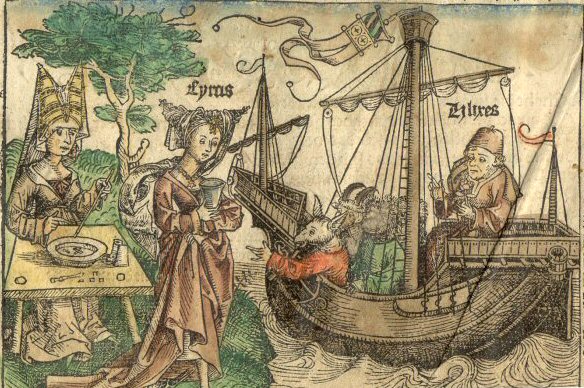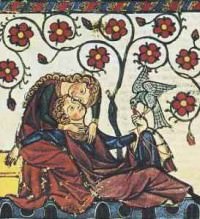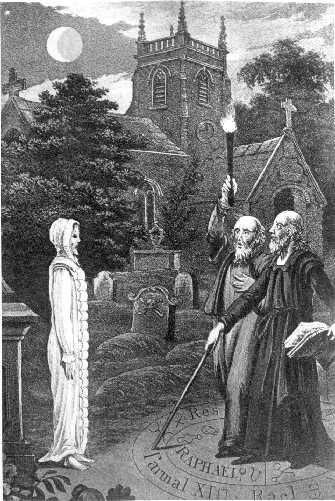
Happy Halloween! Here is a little more about witchcraft during the late medieval and early renaissance era, focusing a bit more on the literature of the time and how it helped shaped ideas of women and witches. The first part can be found right below or by clicking here. Enjoy!
Martin Le Franc's 1440 poem Le
Champion de Dames [1] is another important work that helped shape the late medieval image of the witch. Largely a discussion between the Defender and the Adversary of the
achievements and faults of women respectively, this poem not only shows late medieval attitudes concerning women, but also shows women's association with witchcraft. In response to the Defender's claim that women
hold high achievements in arts, the Adversary quickly begins to describe their
deep connection with the devil and witchcraft, painting an incredibly detailed
and fascinating picture. He states:
...not just two or three old women, but more than three
thousand, go together to hidden places to seek out their familiar demons. This
is no joke; this isn't fooling. I'm not trying to lie to you in speaking of
this sorcery...I tell you that I've seen in a written trail record where an old
woman confessed how, since the time she was just sixteen years old that on
certain night she flew on a broomstick from Valpute and went directly to the
awful synagogue of devils. [2]
Another fundamental aspect of
witchcraft included the ability to transform, either themselves or another,
into a creature or beast. This strong and terrifying notion is expressed in the
Malleus Maleficarum with explicit influence of past literature. Upon
this matter the authors Heinrich Kramer and James Sprenger state:
For we have learned much of this matter from the Knights of
the Order of S. John of Jerusalem in Rhodes; and especially this case which
happened in the city of Salamis in the kingdom of Cyprus. For that is a seaport
and once when a vessel was being laden with merchandise...a young man went to
the house of a women standing outside the city on the seashore and asked her if
she had any eggs to sell... [4]
 The story goes on to tell how the man bought and ate the
eggs from the old woman, and although he thought he was simply rendered
incapable of speech soon after eating the eggs, he was actually transformed
into an ass, and had to serve in the witches company for three years, for they
were they only beings who would respond to him as if he was human.[5]
Yet historian Gareth Roberts notes that this particular story is given again in
the 16th century Demonomanie, in which its author Bodin
accredits the story to William Archbishop of Tyre, noting that, “If Bodin was
right...the story would go back to at least the twelfth century.” [6]
Regardless of the tale's actual date, the discussion of the validity of the
tale shows how that The Malleus
Maleficarum relied on past accounts or tales. Certainly literature played a
significant role in influencing Kramer and Sprenger.
The story goes on to tell how the man bought and ate the
eggs from the old woman, and although he thought he was simply rendered
incapable of speech soon after eating the eggs, he was actually transformed
into an ass, and had to serve in the witches company for three years, for they
were they only beings who would respond to him as if he was human.[5]
Yet historian Gareth Roberts notes that this particular story is given again in
the 16th century Demonomanie, in which its author Bodin
accredits the story to William Archbishop of Tyre, noting that, “If Bodin was
right...the story would go back to at least the twelfth century.” [6]
Regardless of the tale's actual date, the discussion of the validity of the
tale shows how that The Malleus
Maleficarum relied on past accounts or tales. Certainly literature played a
significant role in influencing Kramer and Sprenger.
Interestingly, the witch’s
ability to transform is also heavily influenced by figures from the classical world.
As old mythological texts from the ancient world were slowly being incorporated
into the14th and 15th century society, they were entering
a world in which the image of harmful magic and the witch was slowly being
formulated. The result of this is a
reinterpretation of figures such as Circe, who in classical mythology
transformed those traveling with Odysseus into various animals. [7]
With Homer's Circe as influence, Roberts suggests that Circe “often figures as
evidence of witchcraft and her reputed power to transform obviously exercised
demonological discussions.”[8]
Although the assistance of a demon was absent in Homer's characterization of
Circe, intellectuals and writers during the renaissance, fueled by current
discussions of demons, necromancy and witchcraft, reinserted her image into
literature and art to fit their own ideas. The 1493 woodcut published in
Hartman Schedel's Nuremberg Chronicle, for instance shows an elaborately
dressed Circe mixing potions and overseeing a ship full of transformed animals.
Next to her sits her assistant, who points a wand at a dish over a number of
different objects. [9] The
depiction of Circe mixing potions and charms and the inclusion of an assistant
suggests an element of sorcery or witchcraft and that more closely resembles
the sort of alluring magic we see in the piece Necromancy's Messenger Shows
the Pilgrim how Spirits are Raised, mentioned earlier.
 |
| Circe and Ulysses |
In both cases the
one doing magic must hold an instrument to do so (whether it is a sword or
wand), and each sorcerer someone to the left of them, learning or assisting the
other. Although these two pieces are quite different depictions of two very
separate scenes, the image of Circe as one practicing the arts of magic to do
harm to another stands strong, and certainly resonates strong with images of
demon assisted magic. Despite these texts and figures belonging to an entirely
different age, the inclusion of Circe in art shows the late medieval society
actively turning to literature of the past to help define their idea of
witchcraft. From ancient texts, to contemporary art pieces, the evolution of
magic throughout Europe during the Renaissance not only reflects the changing
attitudes toward magic and witchcraft, but also played a significant part in
shaping its definition.
[1]
Kors, Alan, Edward Peters. Witchcraft in Europe, 400-1700.
(Pennseylvania: University Pennsyvania Press. 2001), 167.
[2] Kors, Peters, Witchcraft in Europe, 400-1700, 168
[4] Kramer, Sprenger. The Malleus Maleficarum, 173.
[6]
Barry, Hester, and Gareth Roberts. Witchcraft in Early
Modern Europe. (Cambridge: Cambridge University Press. 1996), 193.
[9] Circe and Ulysses. 1493 woodcut. Hartman Schedel's Nuremberg Chronicle, in Zika, The Appearance of Witchcraft, 134.





